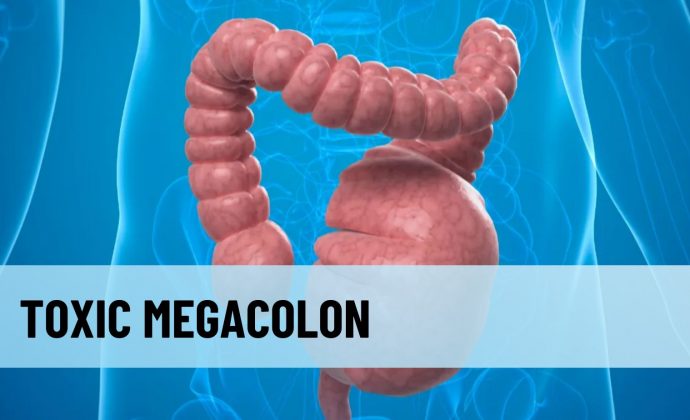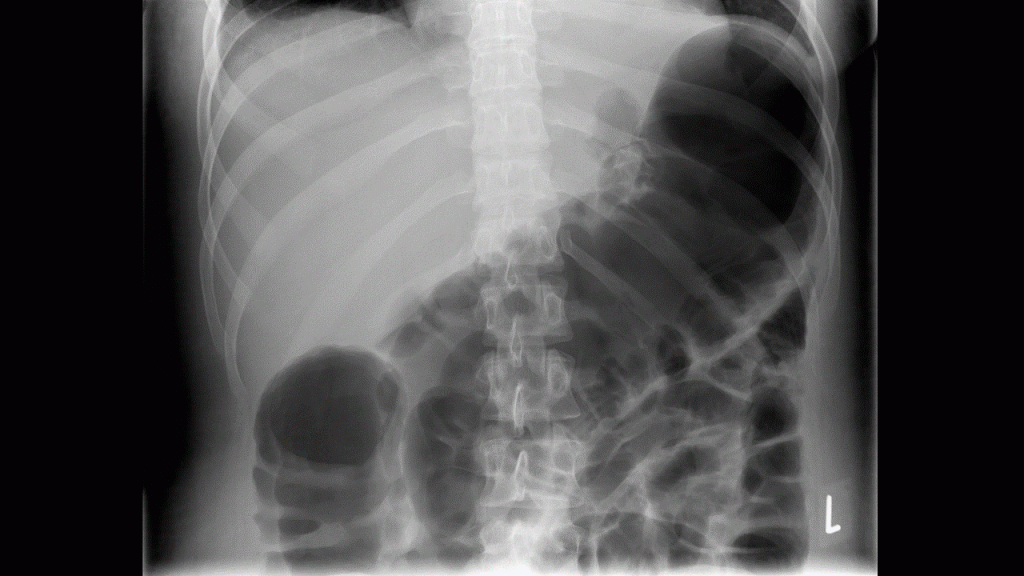
Toxic Megacolon
Toxic Megacolon (TM) is a rare but potentially fatal complication of inflammation of the colon. TM is defined as nonobstructive colonic dilation, greater than 6cm in diameter, which can be total or segmental and is usually associated with systemic toxicity. Any inflammatory bowel condition can predispose to TM.

Causes
Toxic megacolon can be a potential complication of any disease that causes infectious colitis. Some of the conditions that are common causes of Toxic megacolon:
• Inflammation. Inflammatory bowel disease (IBD) is the most common cause of toxic megacolon. There are two main forms: ulcerative colitis (UC) and Crohn’s disease.
• Infection. Toxic megacolon can be caused by infection, both bacterial and parasitic infections. Such as Clostridium difficile; Salmonella; Shigella; Campylobacter colitis; Enterohemorrhagic or enteroaggregative Escherichia coli O157 (can lead to hemolytic-uremic syndrome); Cytomegalovirus; Entamoeba.
• Ischemia
Signs & Symptoms
The most common signs and symptoms are severe bloody diarrhea, abdominal swelling, abdominal pain, fever more than 38 degrees Celsius, heart rate more than 120 beats/minute, neutrophilic leukocytosis more than 10500/micro/L, anemia, dehydration, changes in blood pressure. sensorium, and hypotension. There is also radiographic evidence of colonic enlargement of more than 6 cm.
Risk Factor
Toxic Megacolon is a complication of the following conditions:
• Ulcerative Colitis. This is an inflammatory bowel disease. It usually affects the colon and rectum.
• Crohn’s Disease. This is an inflammatory bowel disease. It can affect any part of the digestive tract.
• Colon infection. It can be caused by C. difficile. These are germs that can cause symptoms ranging from diarrhea to colitis which may be deadly. Other infections can also cause problems.
• Ischemia. Low blood flow to the colon.
• In rare situations, colon cancer.
Other risk factors include diabetes, organ transplantation, kidney failure, immune suppression, and chronic obstructive pulmonary disease.
Diagnosis
To confirm the diagnosis of Toxic megacolon, the doctor will perform a physical examination and history taking regarding the symptoms, as well as review the patient’s medical history. Then follow-up examinations will be carried out such as an X-ray or CT scan of the abdomen to see an enlarged colon and detect blockages, perform a complete blood count test to detect abnormalities in the blood, examine electrolytes in the blood, and perform a colon tissue biopsy.
Treatment
Treatment of Toxic Megacolon is based on the severity and adjusted to the underlying cause. Toxic megacolon treatment includes:
• Drugs. Treating the original condition or infection can reduce Toxic megacolon. Anti-inflammatory drugs can help control inflammation. Antibiotics can help treat or prevent infection.
• Resting the bowel and decompressing the bowel. This treatment can help remove gas and substances that fill the colon.
• IV Fluids. Giving intravenous fluids and electrolytes can help the recovery process and prevent dehydration.
• Operation. If less invasive treatment does not reduce the size of the Toxic megacolon within 2 or 3 days, the patient will be advised to undergo surgery to remove part or all of the colon.
• Some drugs that can worsen the condition of Toxic megacolon include opioids; nonsteroidal anti-inflammatory drugs; medicine to stop diarrhea; antidepressants; anticholinergic drugs.
Complications
Toxic megacolon can cause severe complications if not treated properly, such as bleeding and blood loss; sepsis; bowel perforation; peritonitis; abscess; shock; abdominal compartment syndrome. If not treated, Toxic megacolon can be deadly.
Source:
Skomorochow E, Pico J. Toxic Megacolon. 2022 Jul 5. In: StatPearls [Internet]. Treasure Island (FL): StatPearls Publishing; 2022 Jan–. PMID: 31613459.
Desai J, Elnaggar M, Hanfy AA, Doshi R. Toxic Megacolon: Background, Pathophysiology, Management Challenges and Solutions. Clin Exp Gastroenterol. 2020 May 19;13:203-210. doi: 10.2147/CEG.S200760. Erratum in: Clin Exp Gastroenterol. 2021 Jul 19;14:309-310. PMID: 32547151; PMCID: PMC7245441.
Frysh, Paul. 2021. What is Toxic Megacolon. Diakses pada 09 September 2022, dari https://www.webmd.com/ibd-crohns-disease/ulcerative-colitis/toxic-megacolon-overview#091e9c5e81ca7b79-2-6
Johns Hopkins Medicine. Toxic Megacolon. Diakses pada 09 September 2022, dari https://www.hopkinsmedicine.org/health/conditions-and-diseases/toxic-megacolon
Image Source: stringfixer





 Users Today : 382
Users Today : 382 Total views : 2129226
Total views : 2129226 Who's Online : 7
Who's Online : 7